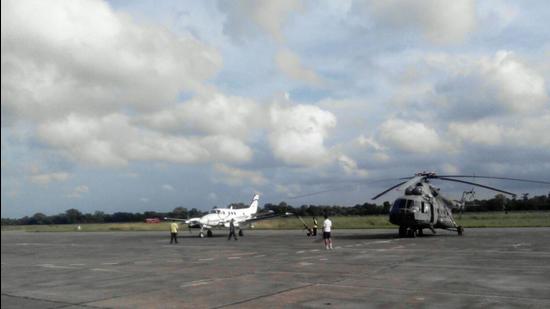In India, the democratisation of air travel
UDAN has allowed first-time flyers to travel at the cost of a first-class train ticket, enhanced access, encouraged regional carriers, and been an economic force multiplier
It has been four years since the central government, under the leadership of Prime Minister (PM) Narendra Modi, embarked on the ambitious task of building a strong and affordable regional aviation system in India. The UDAN scheme has been seminal in its impact, having triggered air connectivity to hitherto unserved regions.

The development and expansion of regional airports such as Darbhanga, Jharsuguda, Kadapa, Nasik, Belagavi, Jagdalpur, Hubli and Kishangarh have brought new destinations onto India’s aviation map and the concomitant unlocking of new economic opportunities in these regions (such as cargo) that were completely unexplored until five years ago.
For instance, the Darbhanga airport, which was built at the time of Independence, and was fully functional from 1950 to 1962, had been wiped off the aviation map. The airstrip was revived under the UDAN scheme, and is now seen as a critical gateway for northern Bihar to the rest of the country. The airport offers connectivity with six to 10 major cities, and currently handles over 150,00 passengers annually.
The Belgavi airport has facilitated travel for students to Belgaum, an education hub. The airport is being utilised for cargo operations as well, and soon will operate a flight training school — all in the span of a few years. Similarly, the Rupsi airport in Assam currently serves four key districts in Assam, as well as the neighbouring states of West Bengal, Meghalaya, and some parts of Bhutan.
Also Read | The cost of crime and criminal justice in India
The Jharsuguda airport in Odisha, another relic of the World War II era, was revamped for operations in 2019. Prior to this, the entire western Odisha region was uncatered for, and the only airport in Odisha was located in Bhubaneshwar, which is 339 km away from Jharsaguda. The airport handled more than 200,000 passengers in 2020-21 with 140 aircraft movements per week. The scheme has also opened up new modes of air transport such as helicopters which are providing access over 16 routes in the remotest areas of Himachal Pradesh and Uttarakhand.
The UDAN scheme has given birth to as many success stories on the other end of the spectrum too i.e; airline operators. We have witnessed a proliferation of new regional carriers, some having pivoted their businesses on the UDAN model: Participation of airline operators in Regional Connectivity Scheme-UDAN rose from five to 11 in the last two years.
Additionally, we were able to operationalise seven airports, two heliports and one water aerodrome in the last year despite the disruptions caused by Covid-19. Here’s why.
Our metro routes are adequately served, and major airports such as Delhi and Mumbai have already reached the zenith of their passenger-handling capacities. It is but natural that the path ahead for the growth of civil aviation will be paved with greater regional and remote connectivity, and building and serving more underserved or unserved airports/airstrips.
This would fundamentally change civil aviation from an elitist mode of transportation to one where even a person who wears a “hawai chappal” can travel by a “hawai jahaz” — as spelt out under the PM’s vision.
This democratisation of air travel and opening up to a high-volume, low-cost model for civil aviation, much along the lines of the telecom revolution in India, will also have a tremendous bearing on allied sectors such as air cargo, which quite remarkably, boomed during the Covid-19 times. The share of Indian carriers in the international cargo business has increased from 2% to 19% in the last two years.
Also Read | Joe Biden has got it wrong
During the lockdown, air cargo proved to be a lifeline not only for essential commodities, but also for our farmers to ship agri-perishables, especially from the Northeast. Now, with Krishi Udaan becoming the next focal point for the government, air cargo may well become a major force multiplier for the overall growth of the civil aviation sector in India.
At the macro level, the true benefits of this scheme will accrue in the form of huge economic paybacks in the long run. A study by the International Civil Aviation Organization (ICAO) reveals that the output and employment multipliers of the aviation sector are 3.25 and 6.10 respectively i.e. every ₹100 spent on air transport contributes ₹325 to economic output; and for every 100 direct jobs birthed in air transport, 610 jobs are created in the economy as a whole. Thankfully, the government took cognisance of this potential early on, and has been proactively supporting and engaging the aviation sector.
Pre-Covid-19, India was the third-largest domestic aviation market in the world with over 341 million passengers having travelled in FY20. The country was poised to become the third-largest overall market in three years till the Covid-19 headwinds hit markets across the world. However, a huge inequality among flyers has been observed across the world. As per a study by climate campaign group, Possible, in India, only 1% of our households take 45% of the flights, and so, in terms of our potential, we have only scratched the surface.
Under the visionary leadership of PM Modi, the government’s flagship UDAN scheme has allowed a huge chunk of first-time flyers to take flight trips at the cost of a first-class AC train ticket. And by connecting regional skies, we have begun the process of democratising and universalising the tenet that we can all “reach for the skies”!
Jyotiraditya Scindia is the Union minister for civil aviation
The views expressed are personal
Continue reading with HT Premium Subscription




